Export Results to Azure Blob Storage
You can set up an export of analytics and list results to Azure Blob Storage for the following clean room types:
Hybrid
Confidential Computing
LinkedIn
Note
Partners invited to a clean room must have their export destination connections (grouped under "Destinations") approved by clean room owners. Contact your Customer Success representative to facilitate the approval.
For Azure exports originating from Confidential Computing clean rooms, notify your LiveRamp contact as LiveRamp needs to add your Azure Blob Storage to the firewall allowlist. If you joined the project mid-configuration and are unsure if your clean room is Confidential Computing and needs this step, contact your LiveRamp Clean Room account team.
Configuring exports outside of a clean room (such as at the organization level) is still supported, but will be deprecated. Setting up clean room question exports within a clean room is recommended.
Overall Steps
Perform the following overall steps in Microsoft Azure to set up an export of analytics and list results to Azure Blob Storage:
Once the above steps have been performed in Microsoft Azure, perform the overall steps in the sections below in LiveRamp Clean Room.
For information on performing these steps and for export details, see the sections below.
Configure Access for the Service Principal
The AD Service Principal needs to have read, write, and delete access to the target Azure Blob Storage location.
Note
For information on creating Azure AD Service Principals, see Microsoft's Learn site.
To configure access for the Service Principal, perform the following steps in the Microsoft Azure UI:
Create Microsoft Extra ID App.
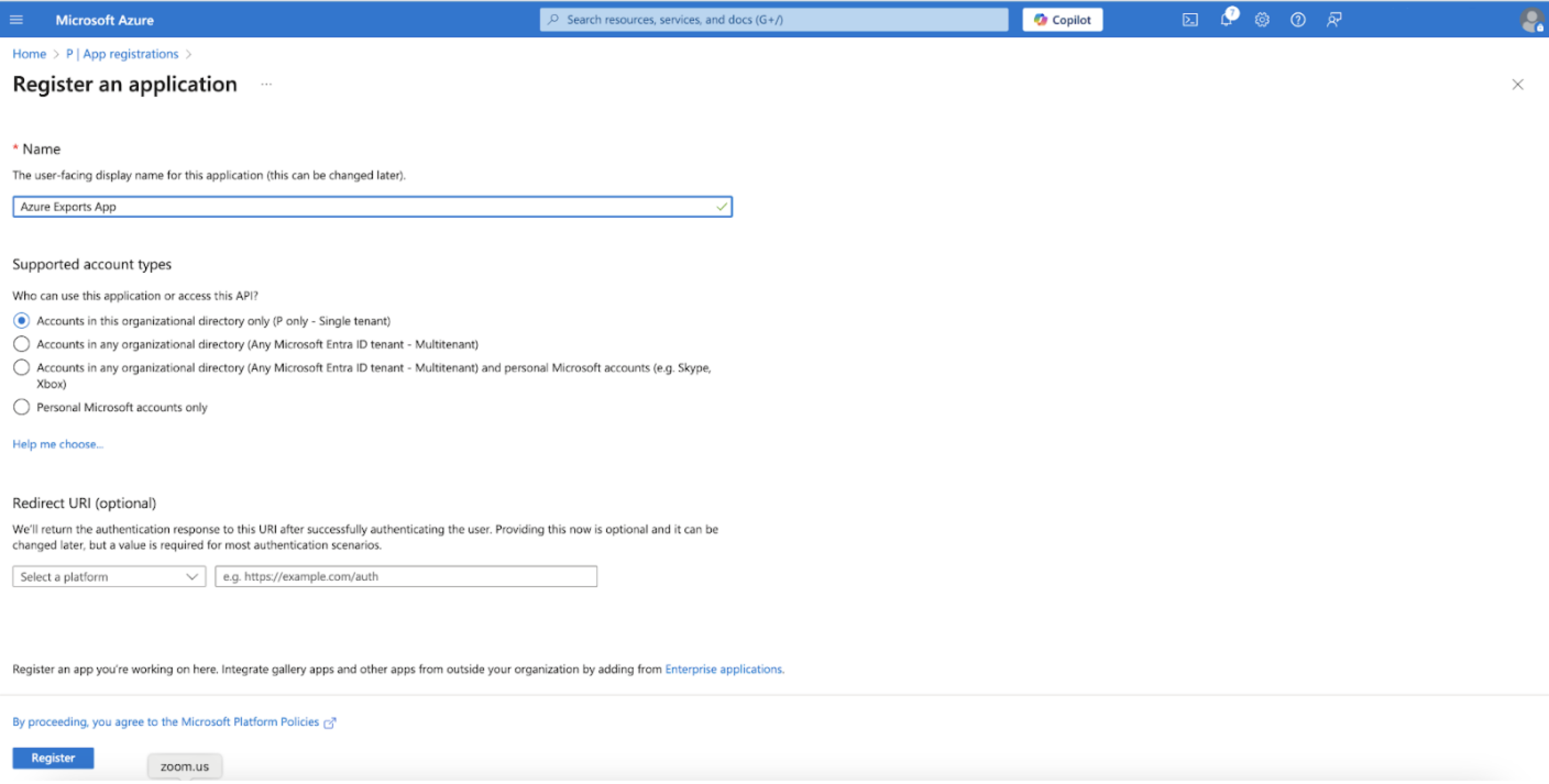
Generate a secret for the created app.
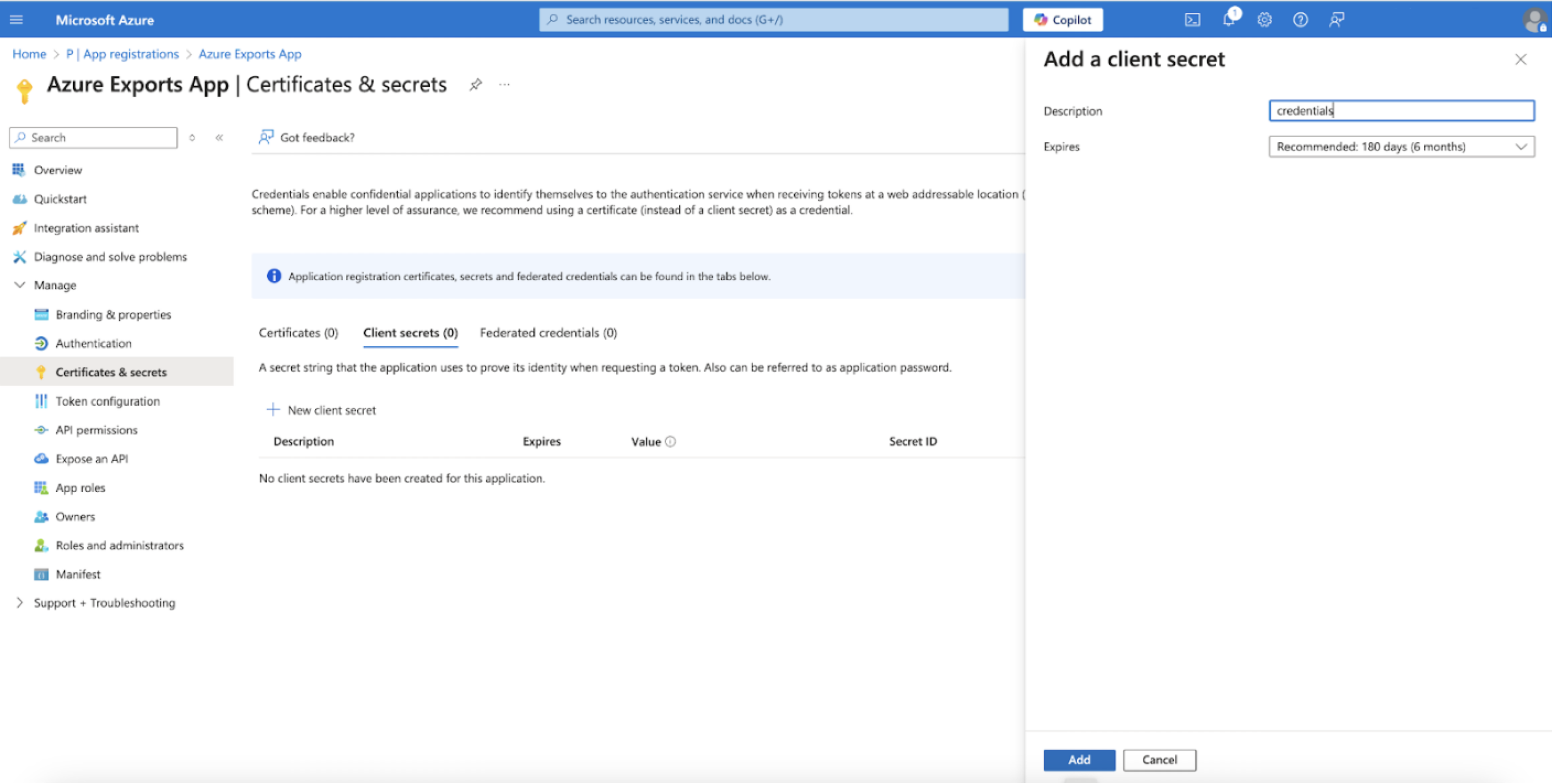
Add required roles to the Extra ID app:
Navigate to the storage account which will be used for exports and select Access Control (IAM).
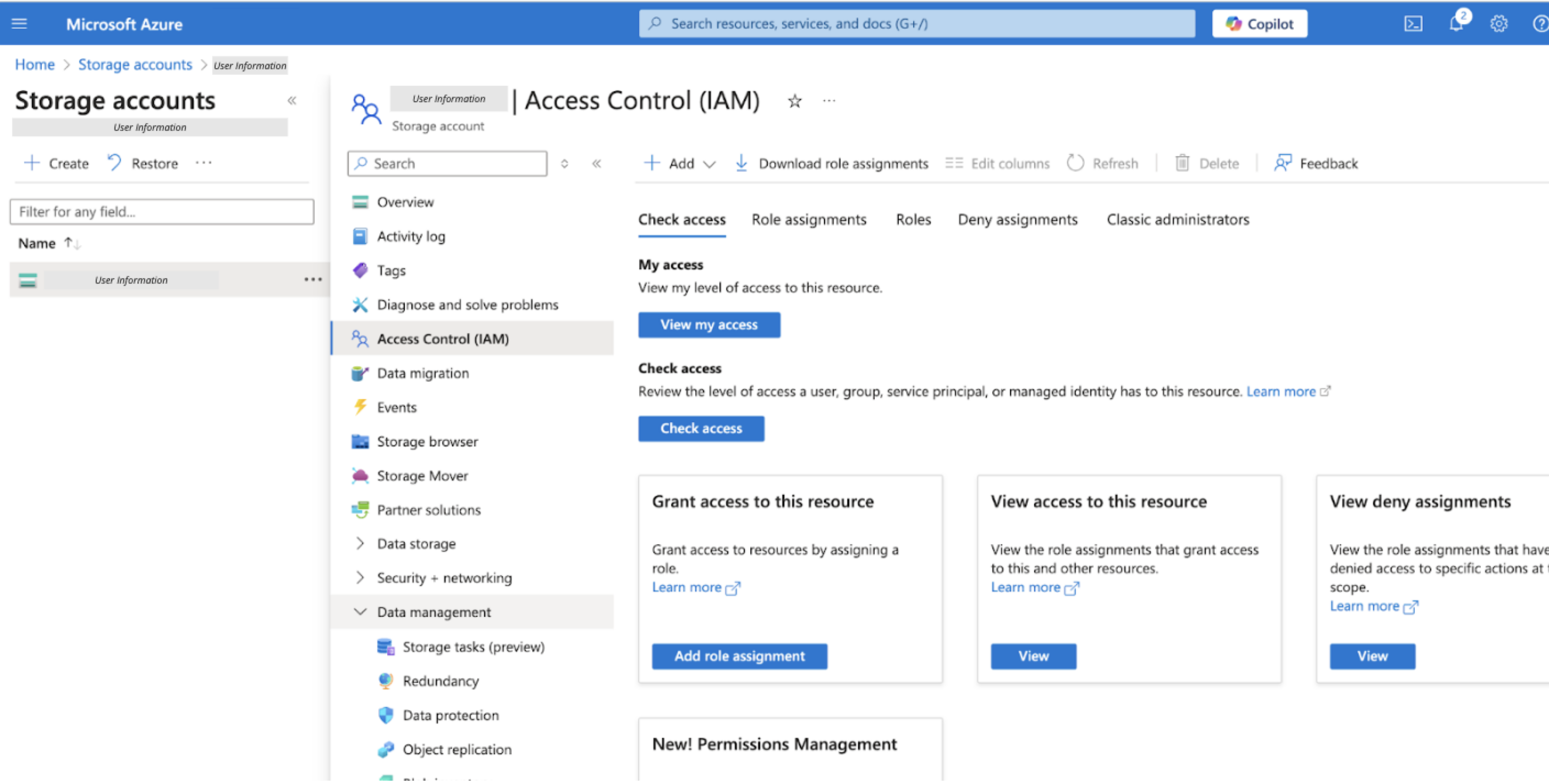
Create a Role assignment and add the role "Storage Blob Data Contributor" to it.
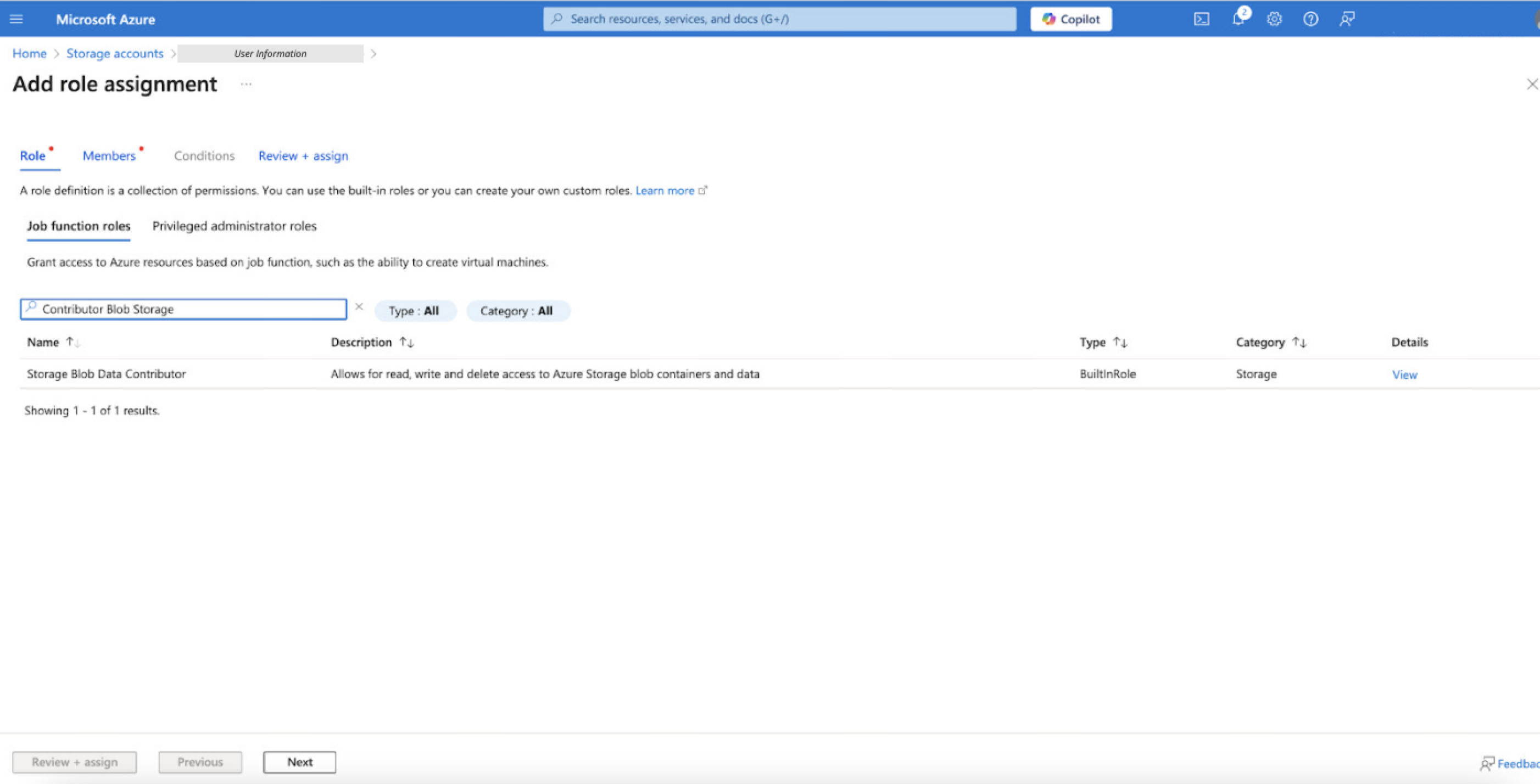
During role assignment, in the members section add the Microsoft Extra ID app created earlier.
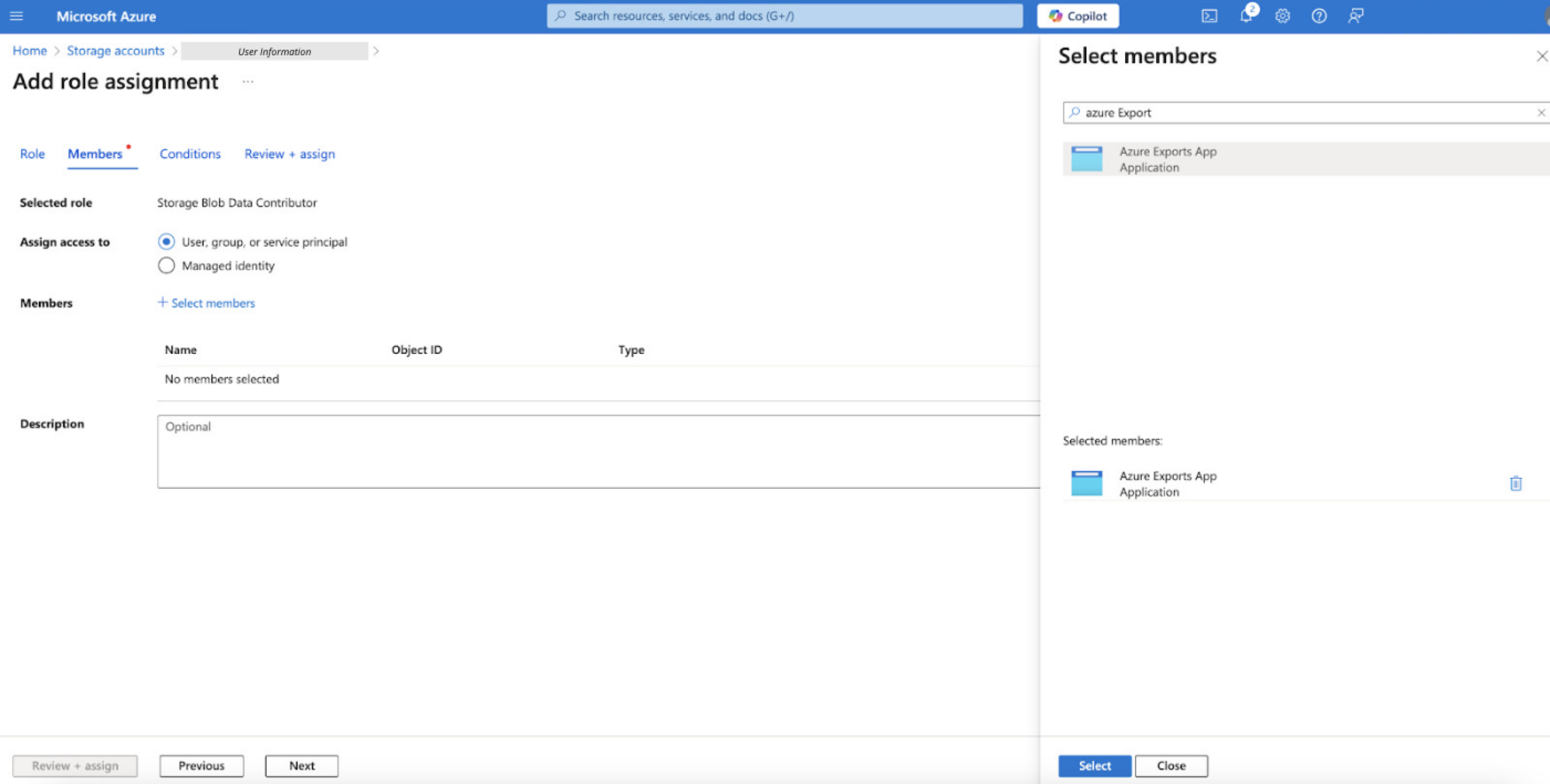
Use the Tenant ID, Client ID, and Client Secret during the procedure in the "Add the Credentials" section below .
Perform Steps in LiveRamp Clean Room
Once the above steps have been performed in Microsoft Azure, perform the overall steps in the sections below in LiveRamp Clean Room.
Enable the Clean Room for Exports
Before setting up an export, the clean room owner must enable exports for the selected source clean room (if not already done during clean room creation):
From the navigation menu, select Clean Room → Clean Rooms to open the Clean Rooms page.
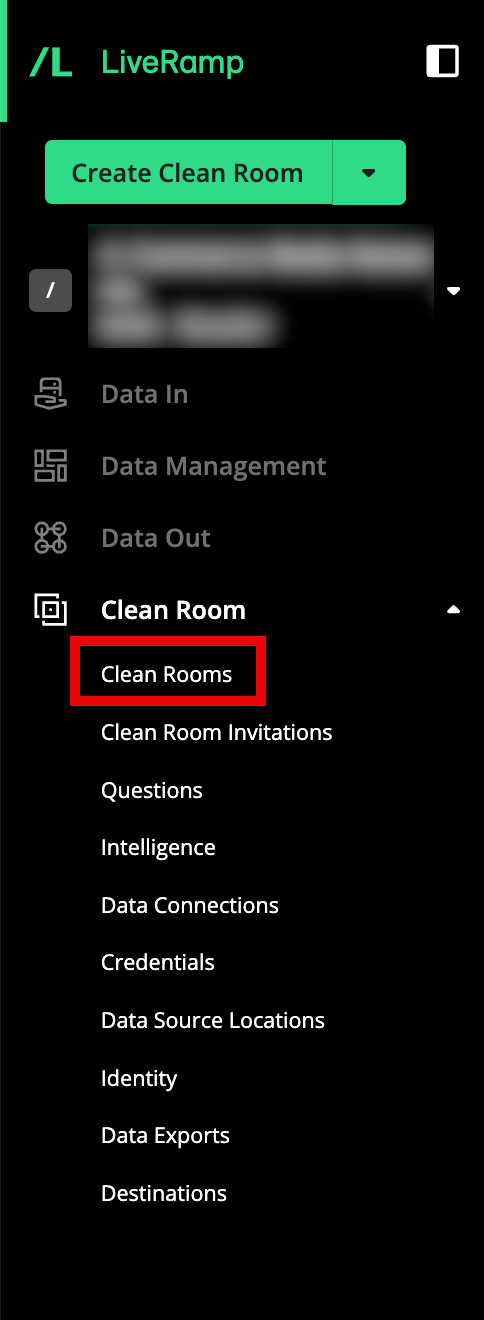
In the row for the clean room you would like to export from, click the More Options menu (the three dots), and then select Edit.
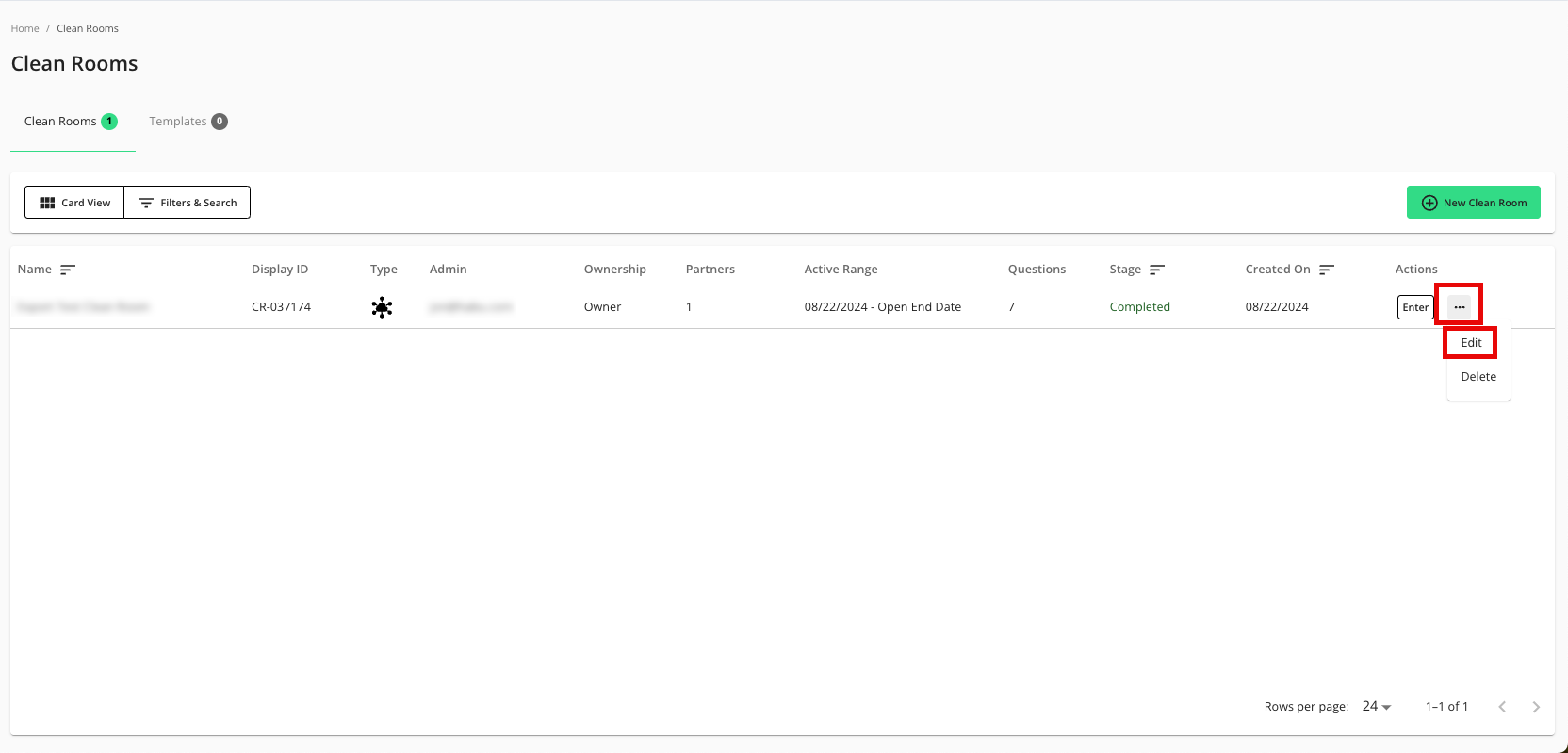
From the Configuration step, click .
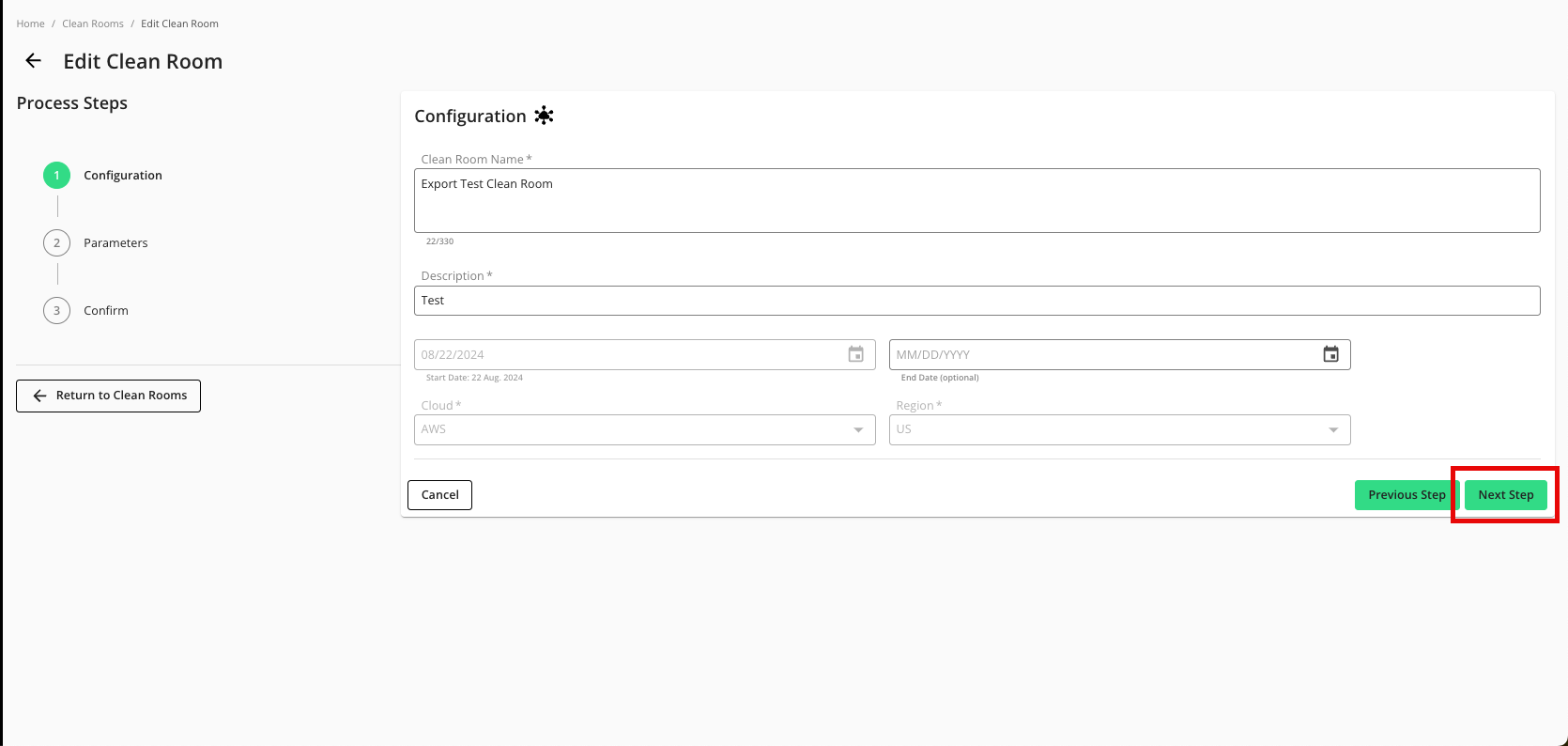
From the Parameters step, adjust any data control parameters as needed and then slide the Enable Export toggle to the right.
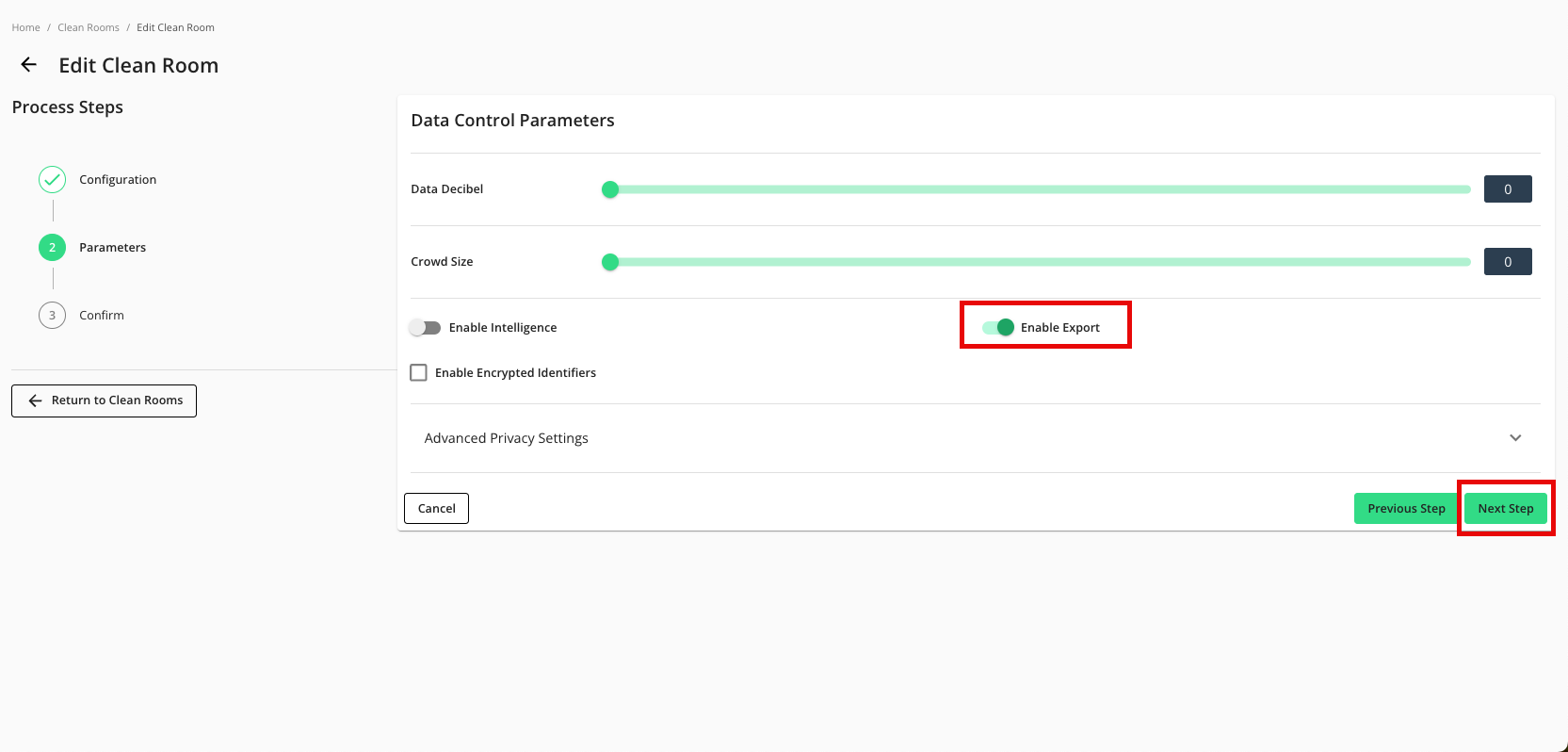
Click .
Verify that your data control parameters are correct and then click .

Add the Credentials
To set up an export to a cloud location, you must configure your Azure AD Service Principal credentials for your Organization:
From the navigation menu, select Clean Room → Credentials to open the Credentials page.
Click .
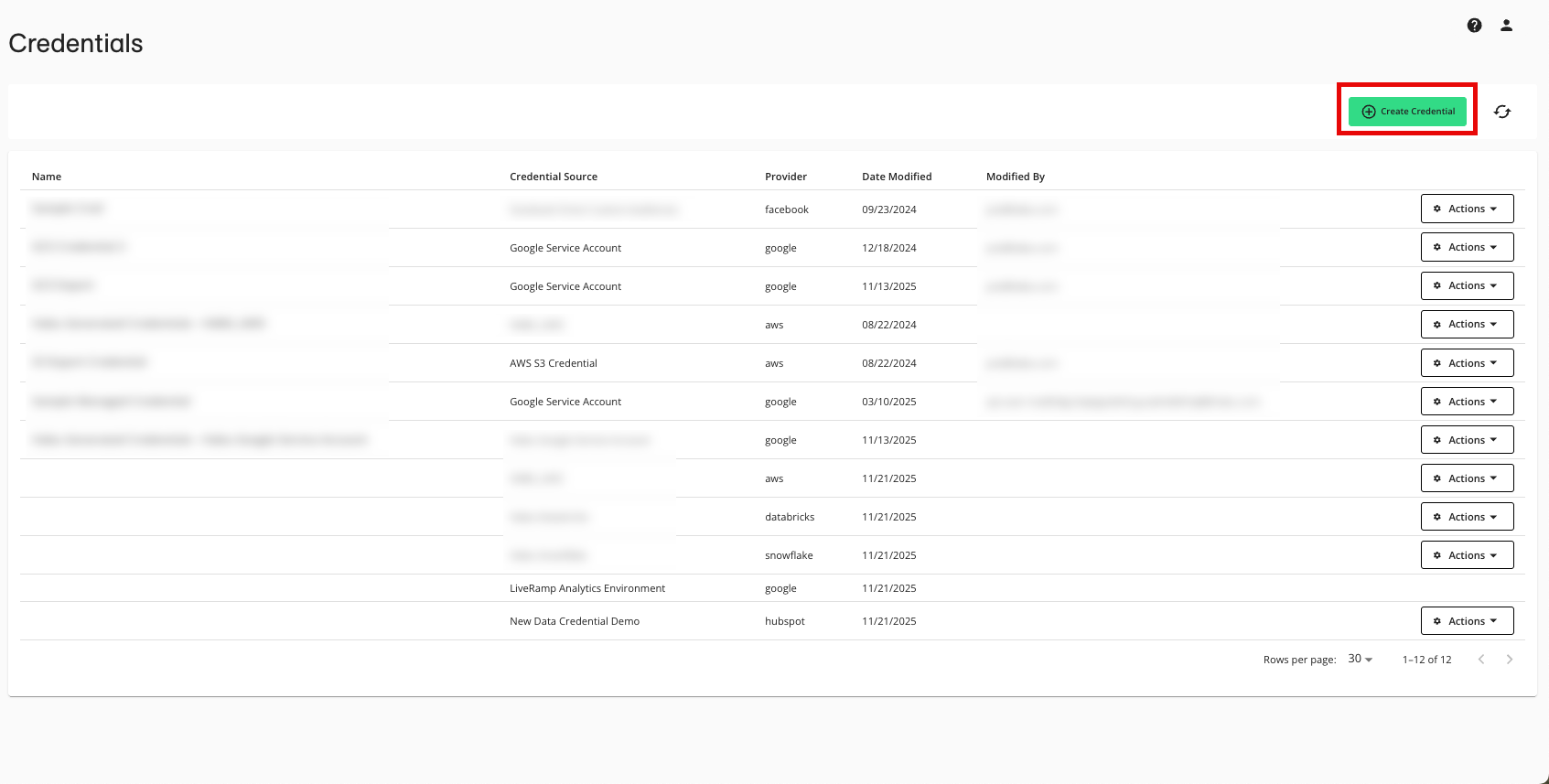
Enter a descriptive name for the credential.
For the Credentials Type, select Azure AD Service Principal.
Enter the following information for your AD Service Principal:
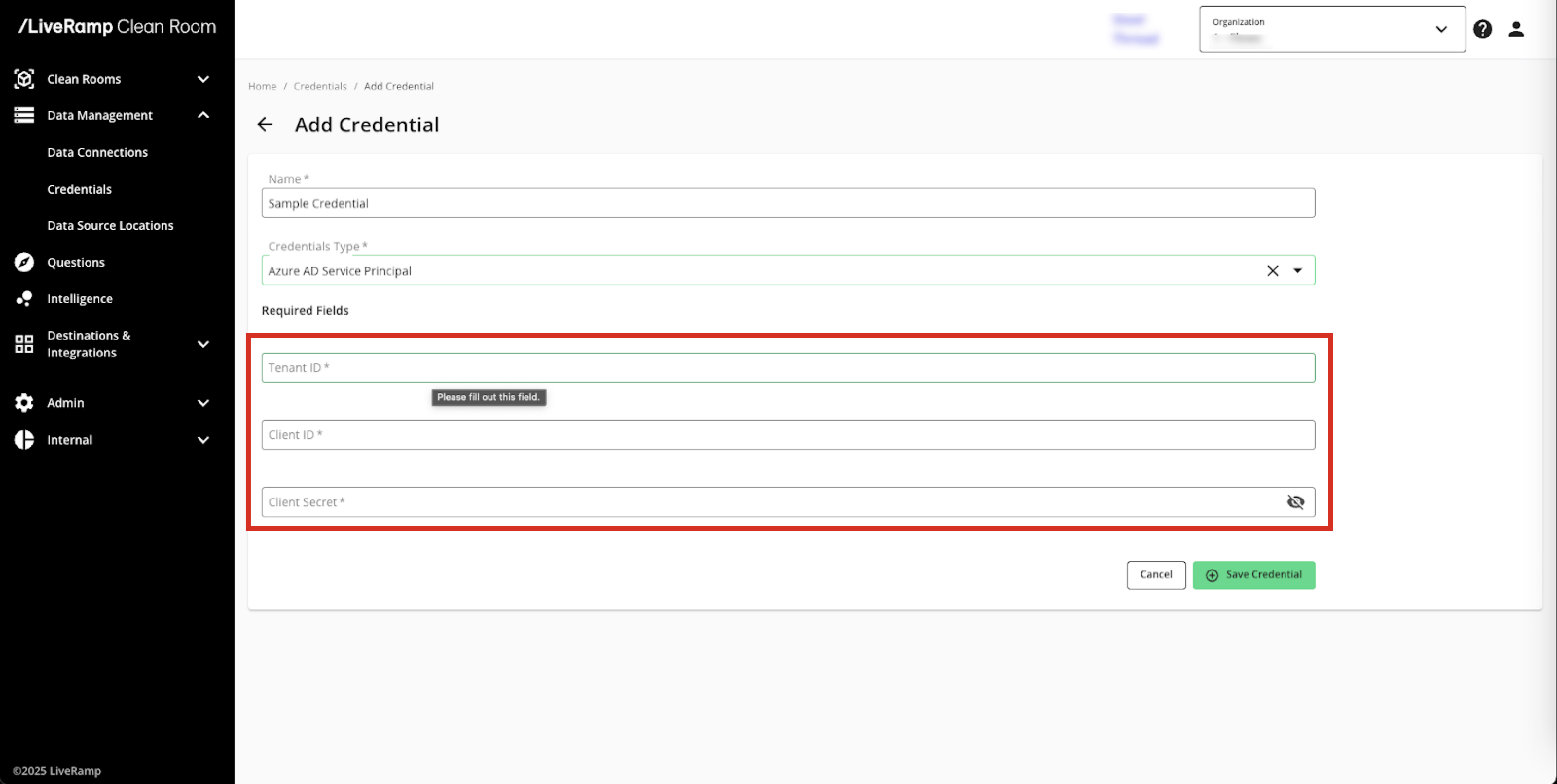
Tenant ID
Client ID
Client Secret
Click .
Verify that your credentials have been added to LiveRamp Clean Room:
Create an Export Destination Connection
To create an export destination connection:
From the navigation menu, select Clean Room → Destinations to open the Destinations page.
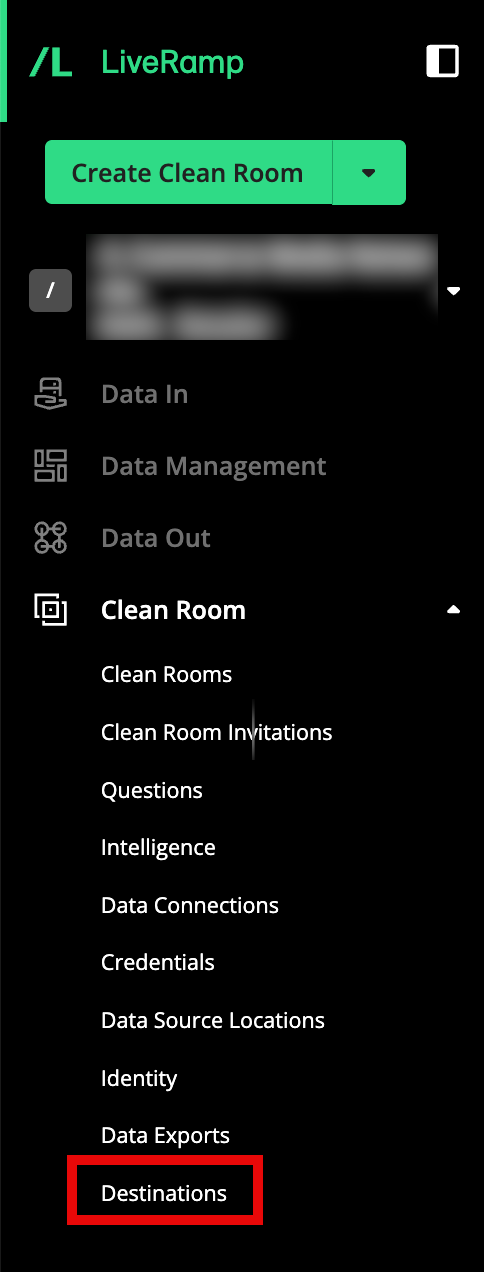
Click .
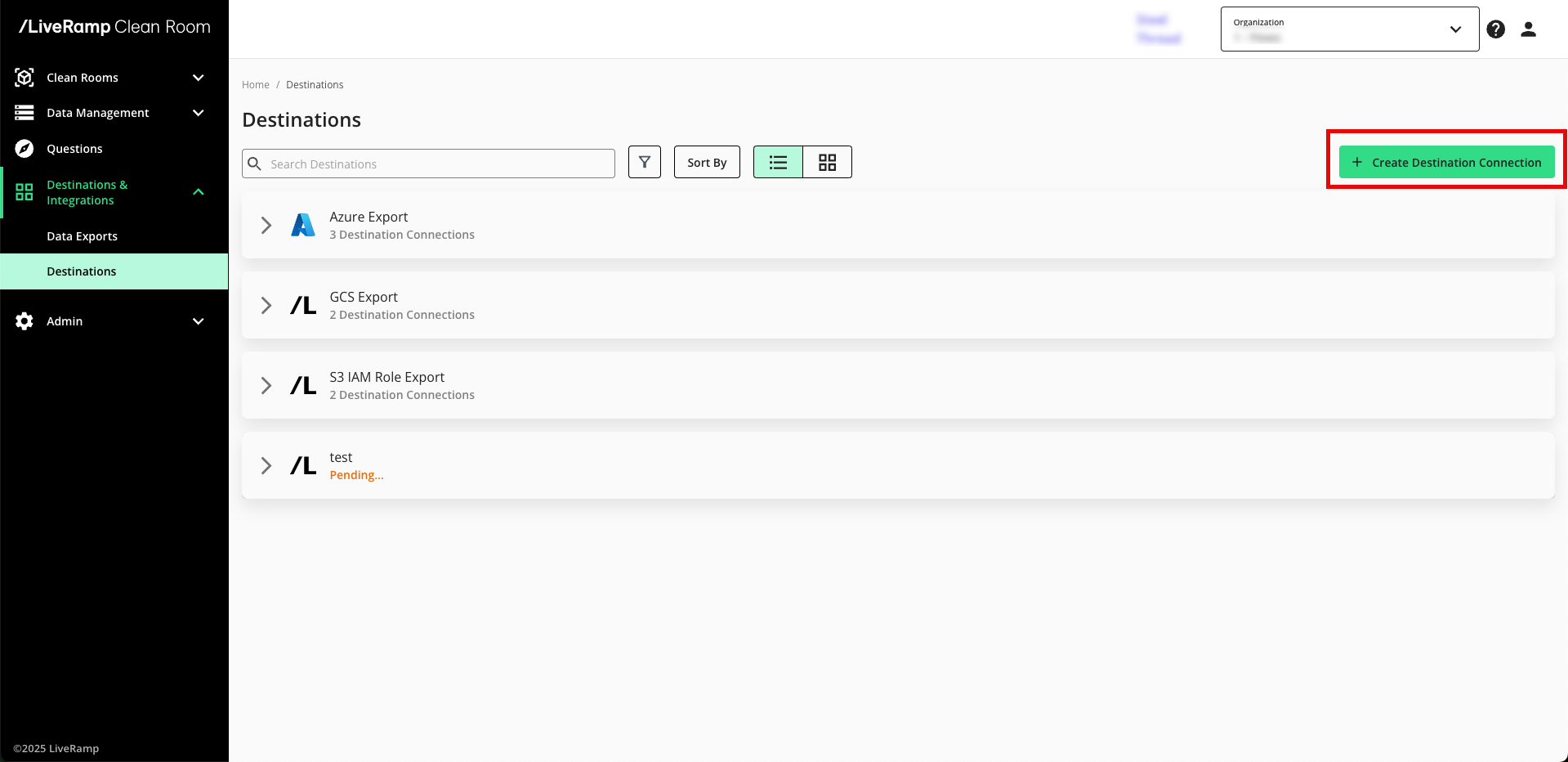
Select Azure Export.

Enter a name and select the Azure AD Service Principal credential created in the "Add the Credentials" section above.
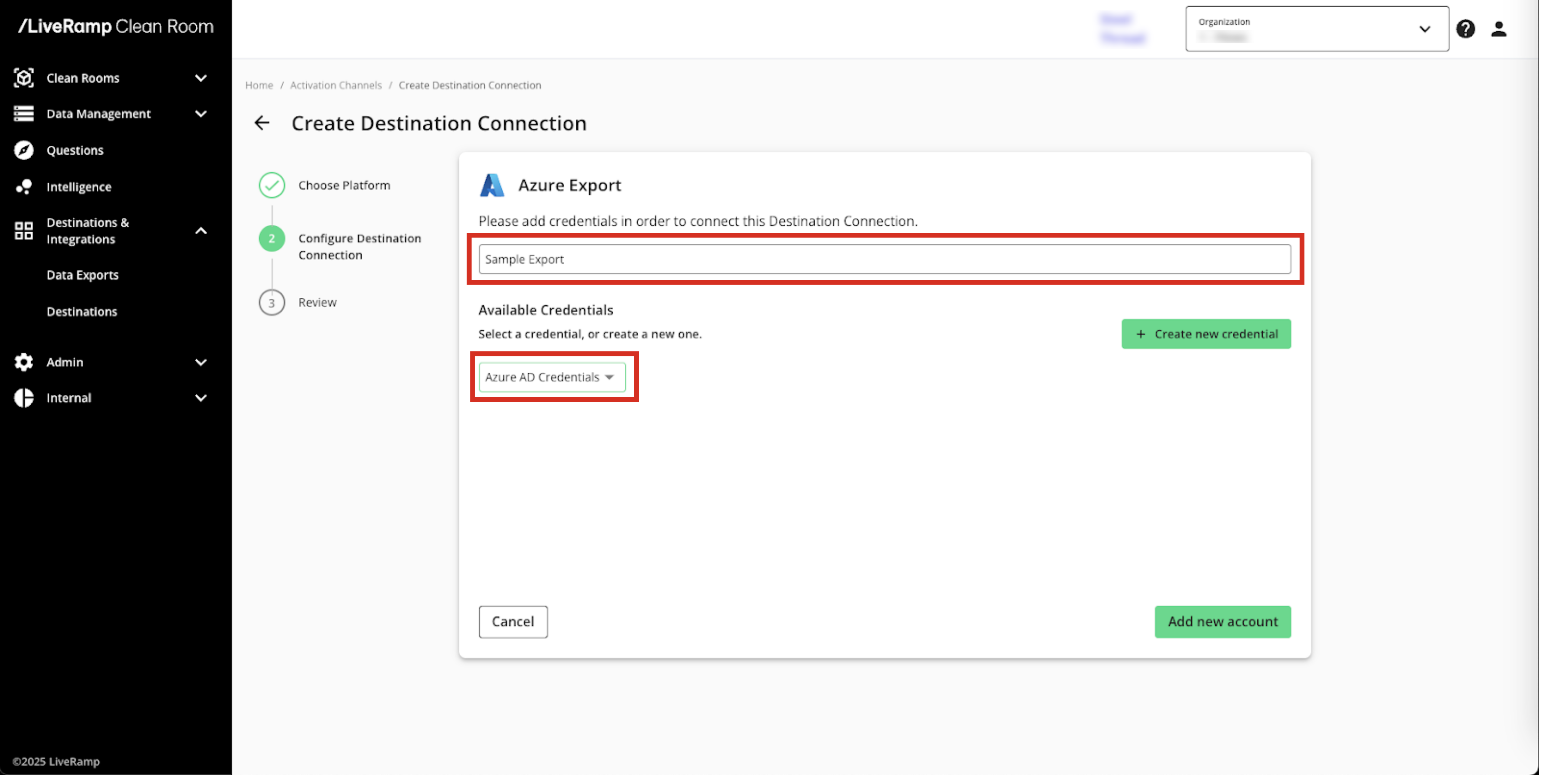
If you're going to encrypt any fields in the data you export to this destination connection, enter your public key (otherwise, leave this field blank).
Click .
Confirm that the new destination connection has been added to your list of Azure Export destination connections.
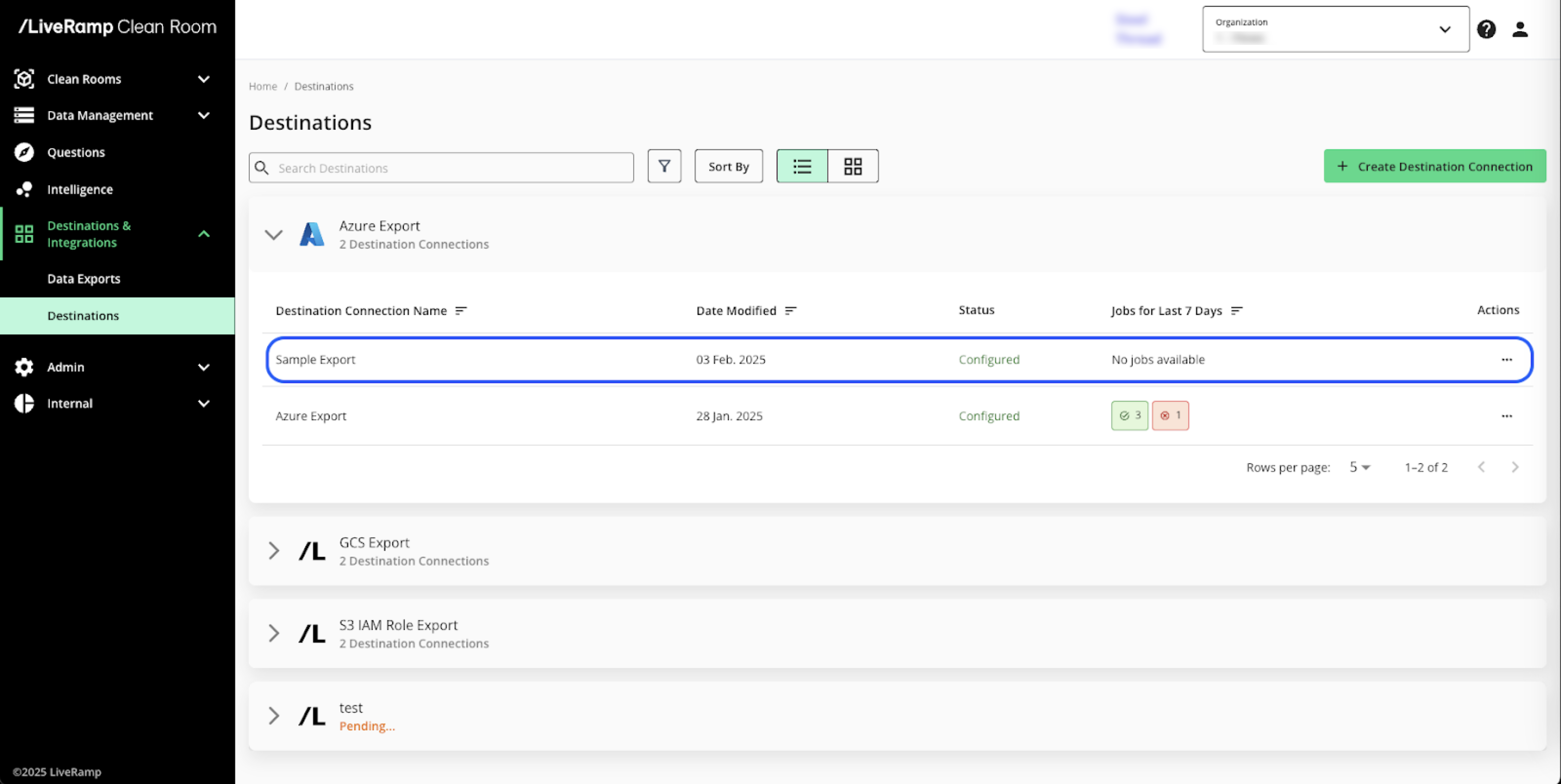
Note
The status of the destination connection will initially be "Configured", but you can continue to export data. Once the first successful export has been processed, the status changes to "Complete".
Provision a Destination Connection to the Clean Room
Once you've created a destination connection, you can provision that destination connection to the clean room you want to export results from:
Note
In most situations, only the clean room owner can provision export destinations using this method. To give clean room partners the ability to provision destinations that the owner has created, contact your LiveRamp representative.
From the navigation menu, select Clean Room → Clean Rooms to open the Clean Rooms page.

From the Clean Room navigation pane, select Destinations. The Destinations screen shows all destination connections provisioned to the clean room.
Click .
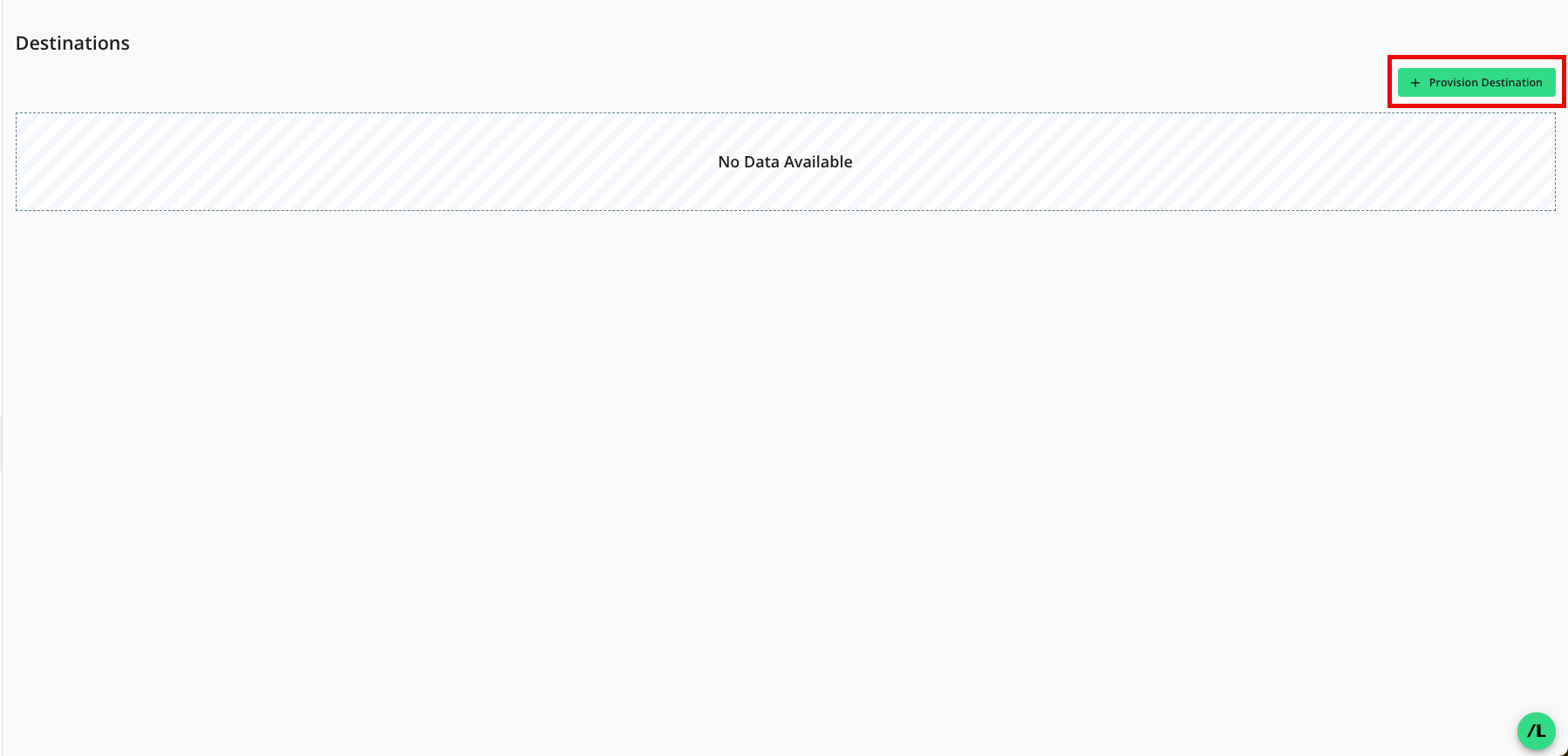
Check the check box for the desired destination connection and then click (AWS S3 example shown).

Verify that your destination connection has been added (S3 IAM example shown).
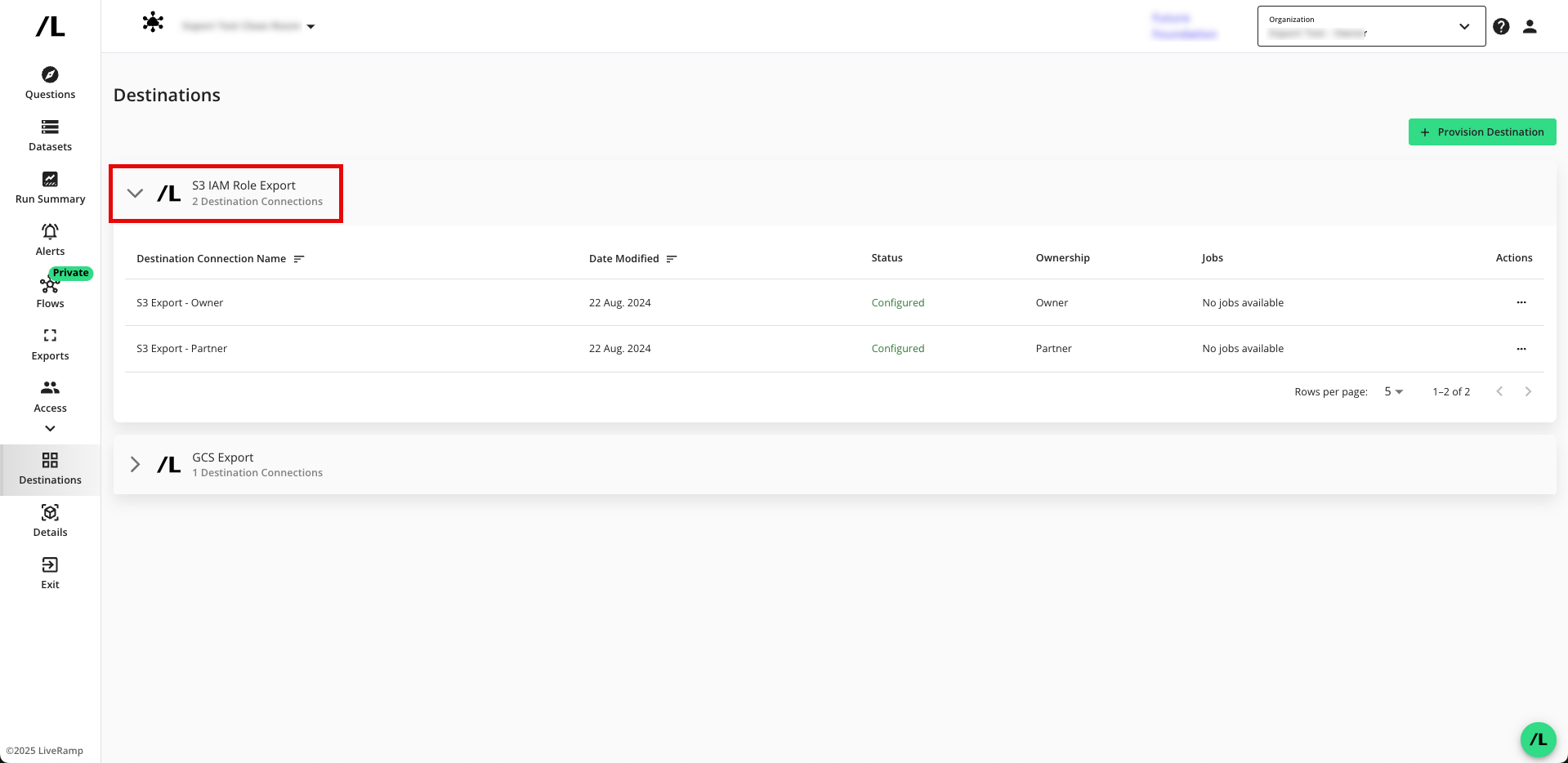
Note
If you're a clean room partner who has been given the ability to request the provisioning of export destinations, the status will show as "Configured (Pending Approval)" until the clean room owner has approved the provisioning of the destination. You can still set up your exports, but the data will not be exported until the request has been approved.
Approve a Destination Provisioning Request
If you're a clean room owner, you're clean room partners can provision export destinations in the clean room, but the status will show as "Configured (Pending Approval)" until you have approved the provisioning of the destination.
To approve the provisioning request:
From the navigation menu, select Clean Room → Clean Rooms to open the Clean Rooms page.

From the Clean Room navigation pane, select Destinations. The Destinations screen shows all destination connections provisioned to the clean room.
Click the caret next to the destination type to view the list of destination connections for that destination type.
For the destinations that show the status as "Configured (Pending Approval)", click .
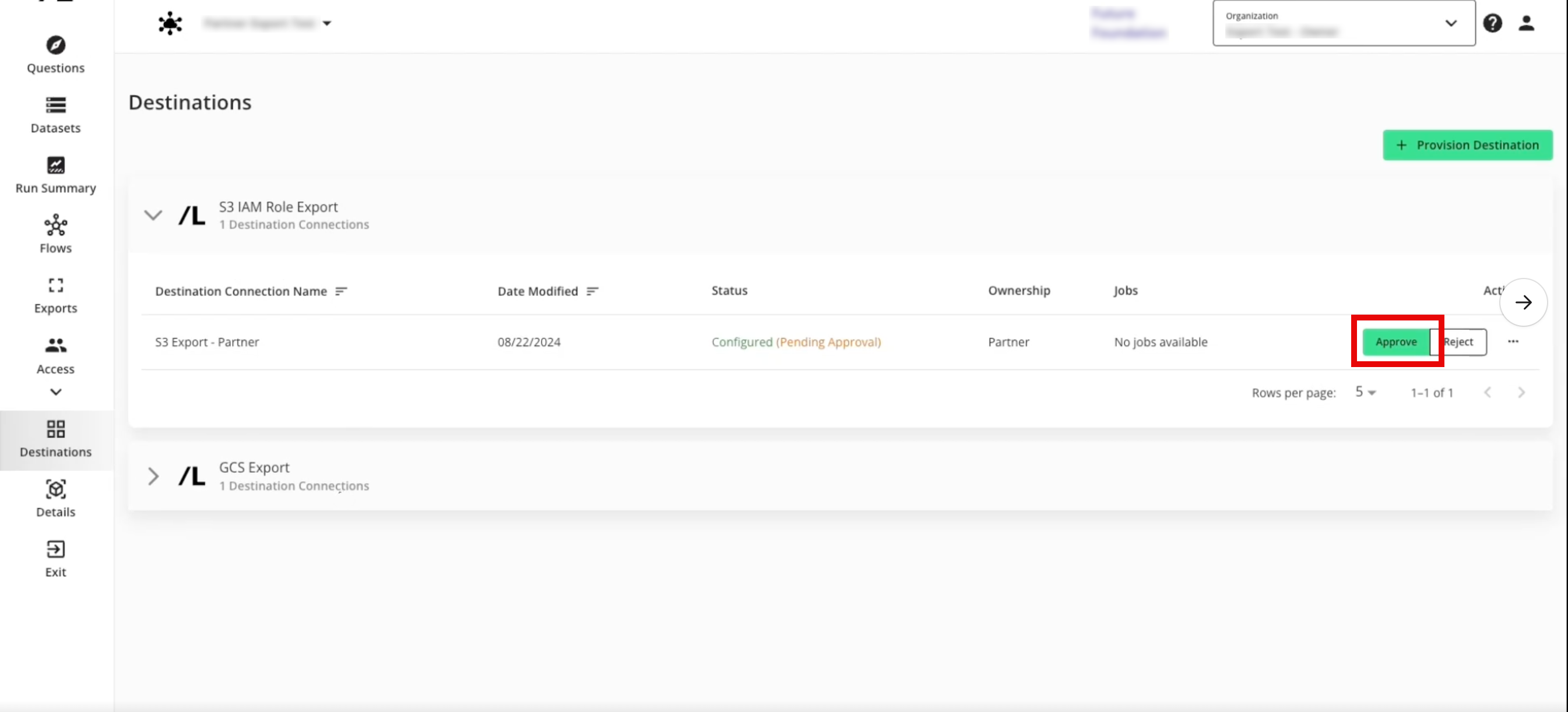
The destination status changes to "Configured".
Create a New Export
After you've provisioned the destination connection to the clean room, create a new export:
From the navigation menu, select Clean Room → Clean Rooms to open the Clean Rooms page.

From the navigation pane, select Clean Rooms → All Clean Rooms and enter a desired clean room.
From the Clean Room navigation pane, select Exports.
Click to open the wizard to create a new export.
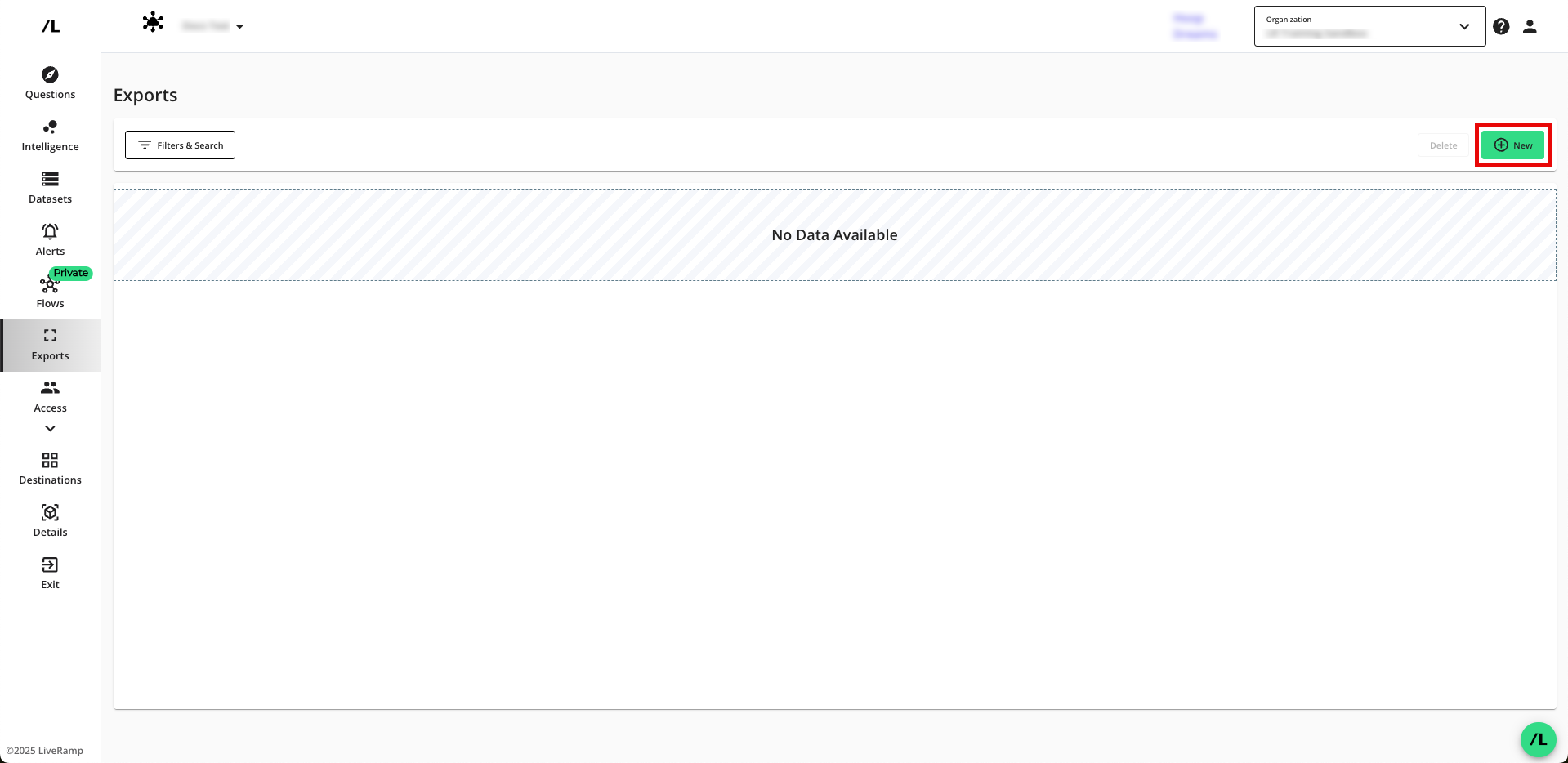
Select the question that you want to export outputs for and then click .
Note
Unless paused, all run outputs will be exported to the configured export destination connection.
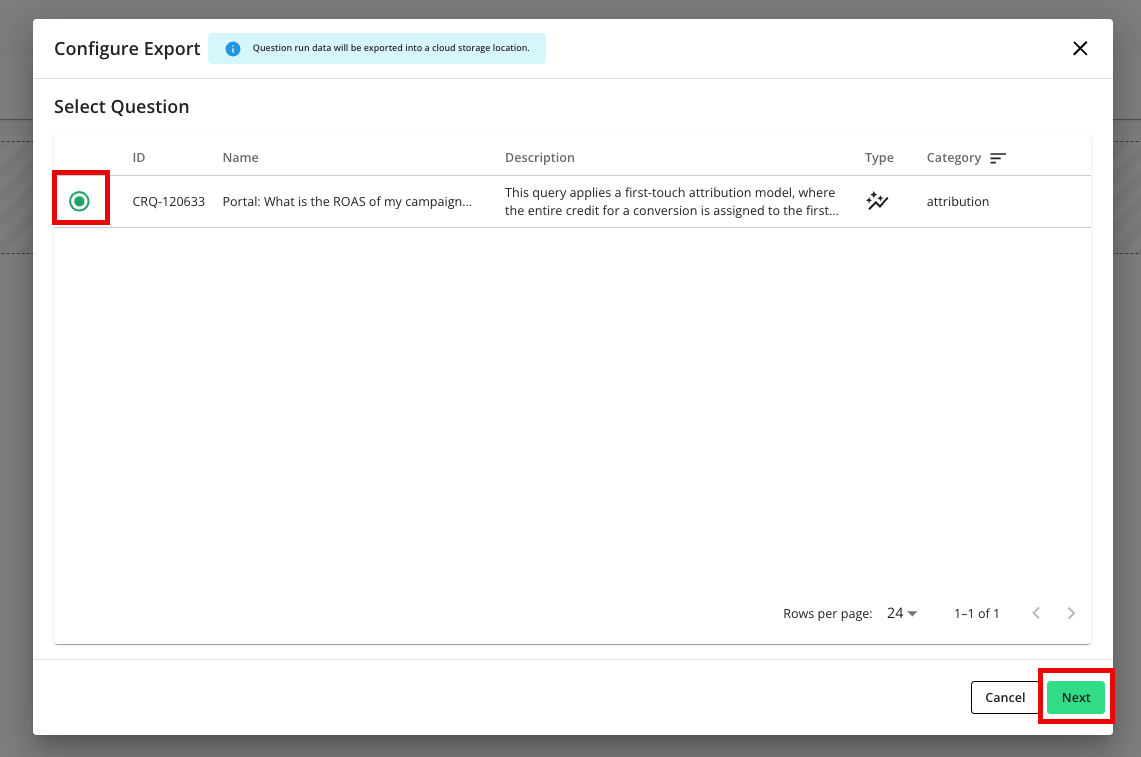
Check the radio button for the specific Azure destination connection you want to send run outputs to.
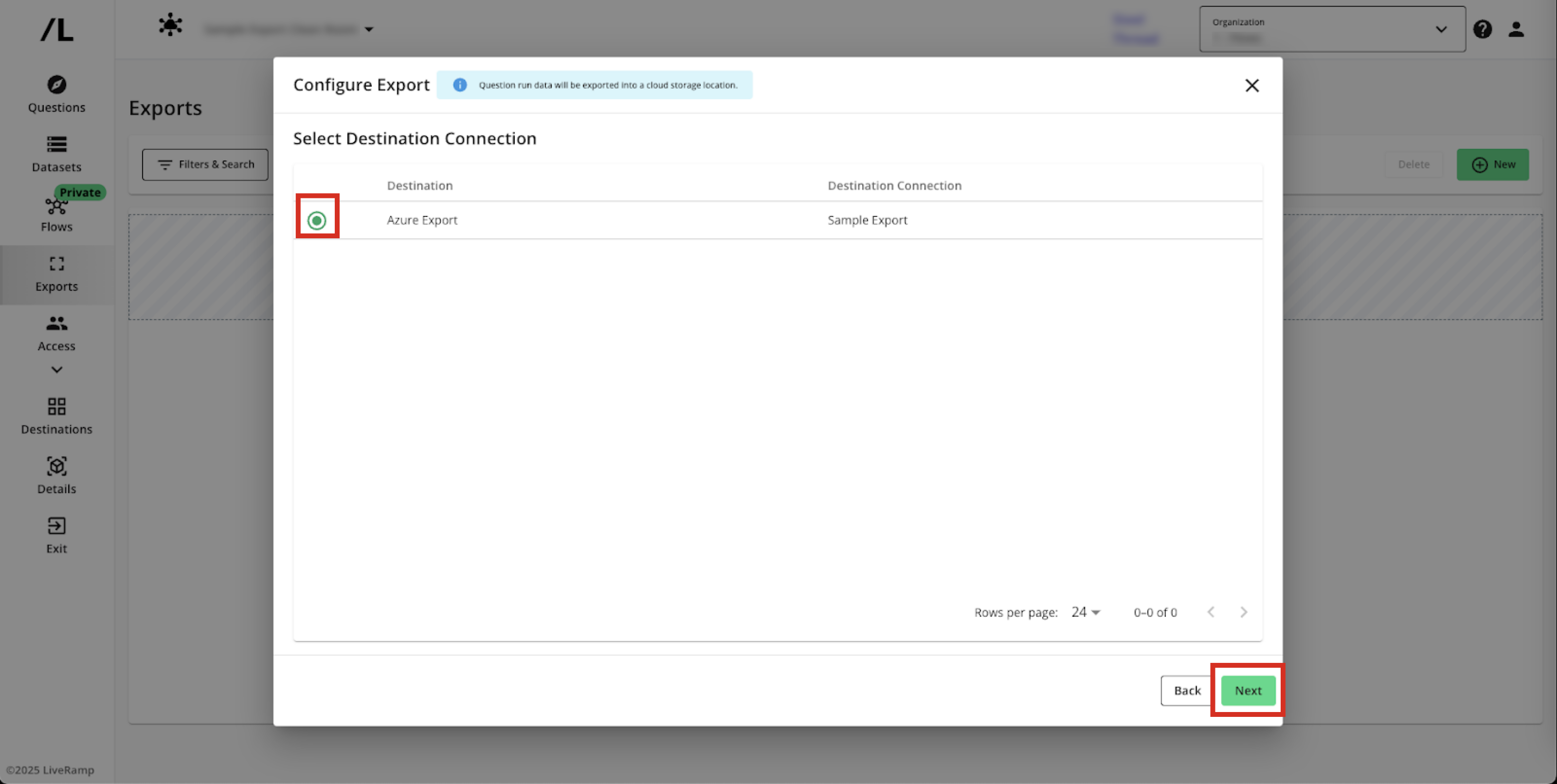
Enter the following information on where you would like the outputs to be exported to and then click .
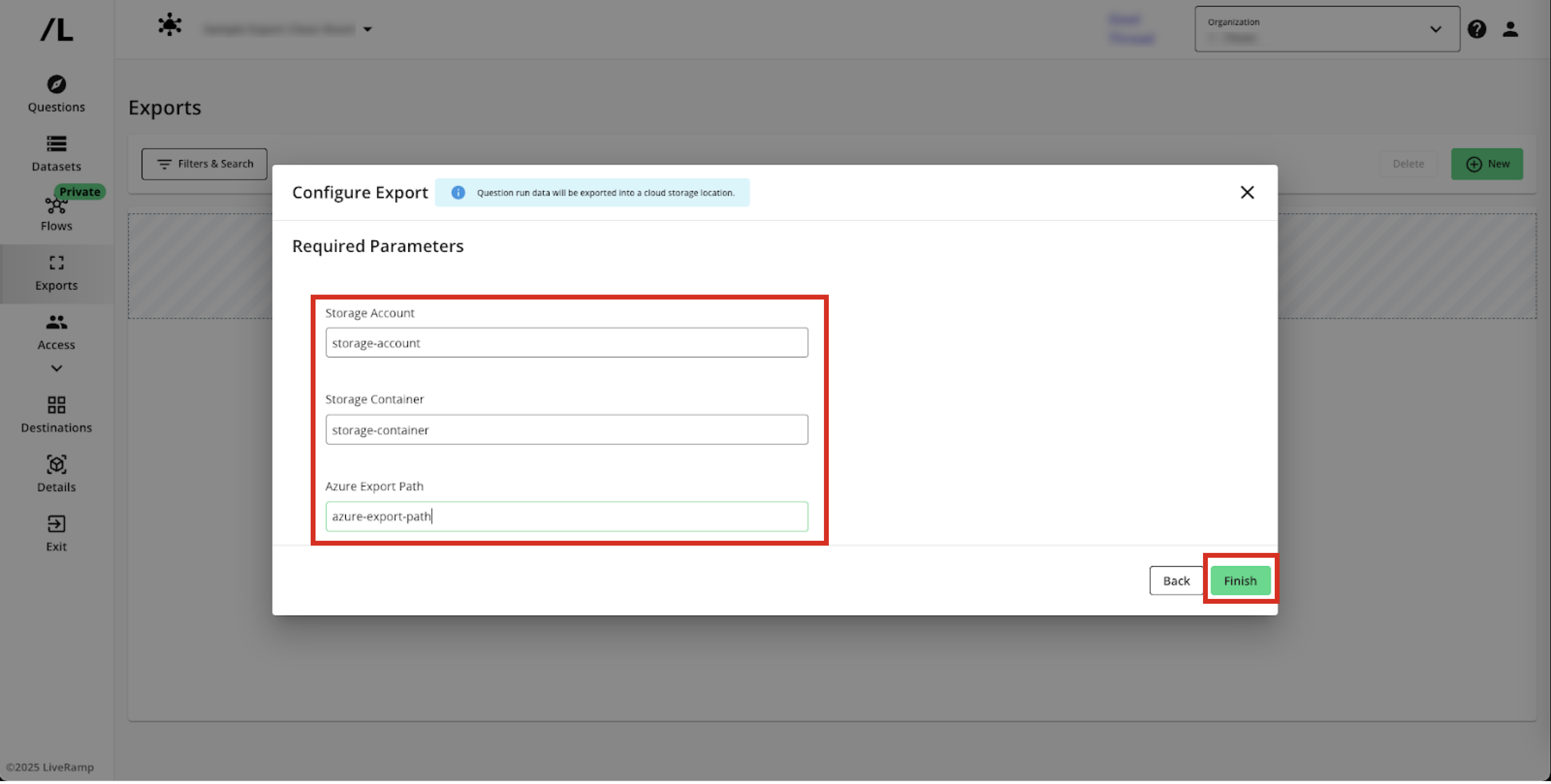
Storage Account
Storage Container
Azure Export Path
Note
In the Azure Export Path field, “/” values are appended before and after the value entered into this field. That is, you do not have to add “/” before or after your folder path.
The values shown in the screenshot above result in a final file path structured as "abfss://storage-container@storage-account.dfs.core.windows.net/azure-export-path/*".
Verify that the job has been created. Exports are added to the page. You may view the details of an export by clicking on the name.
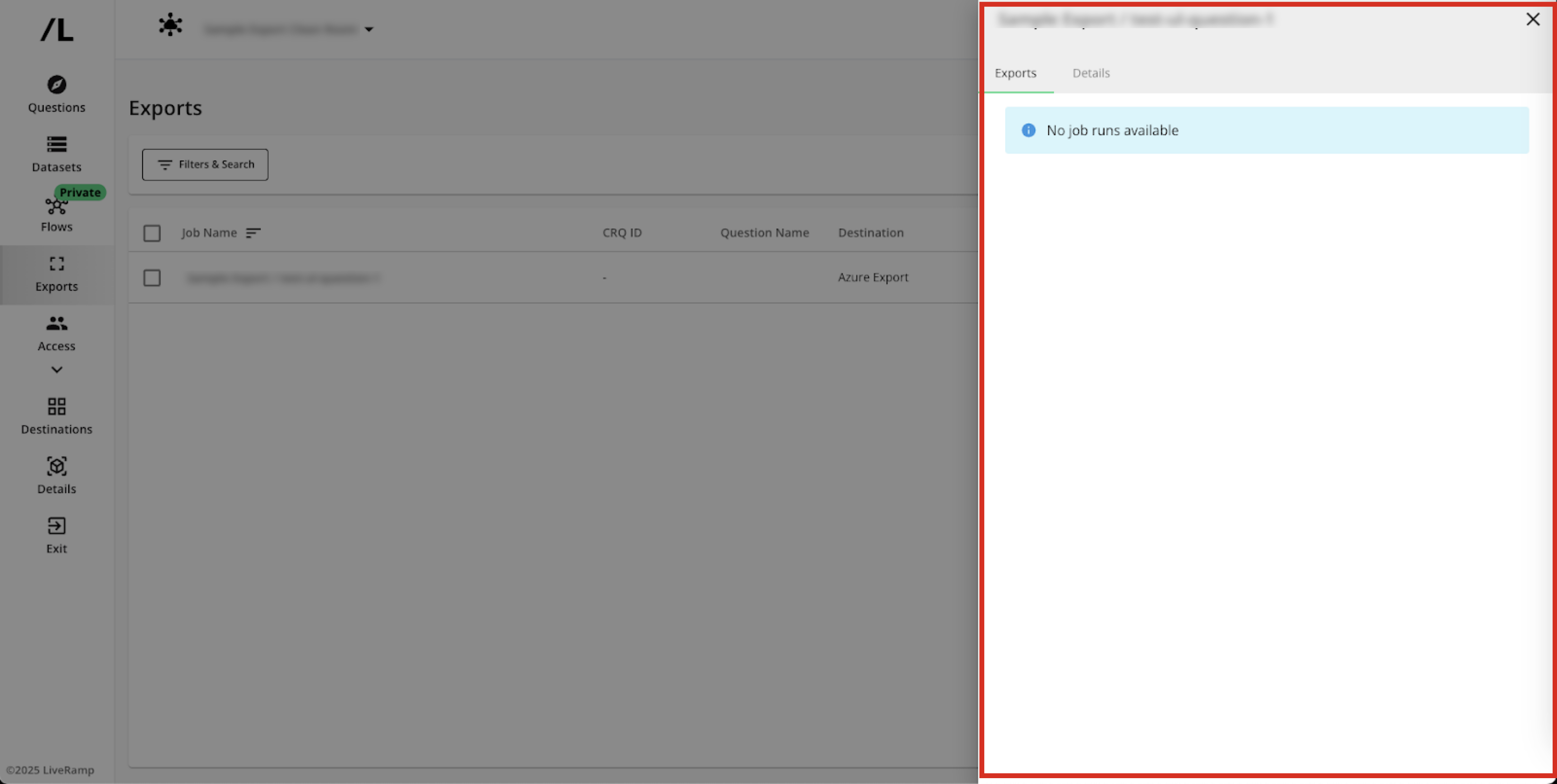
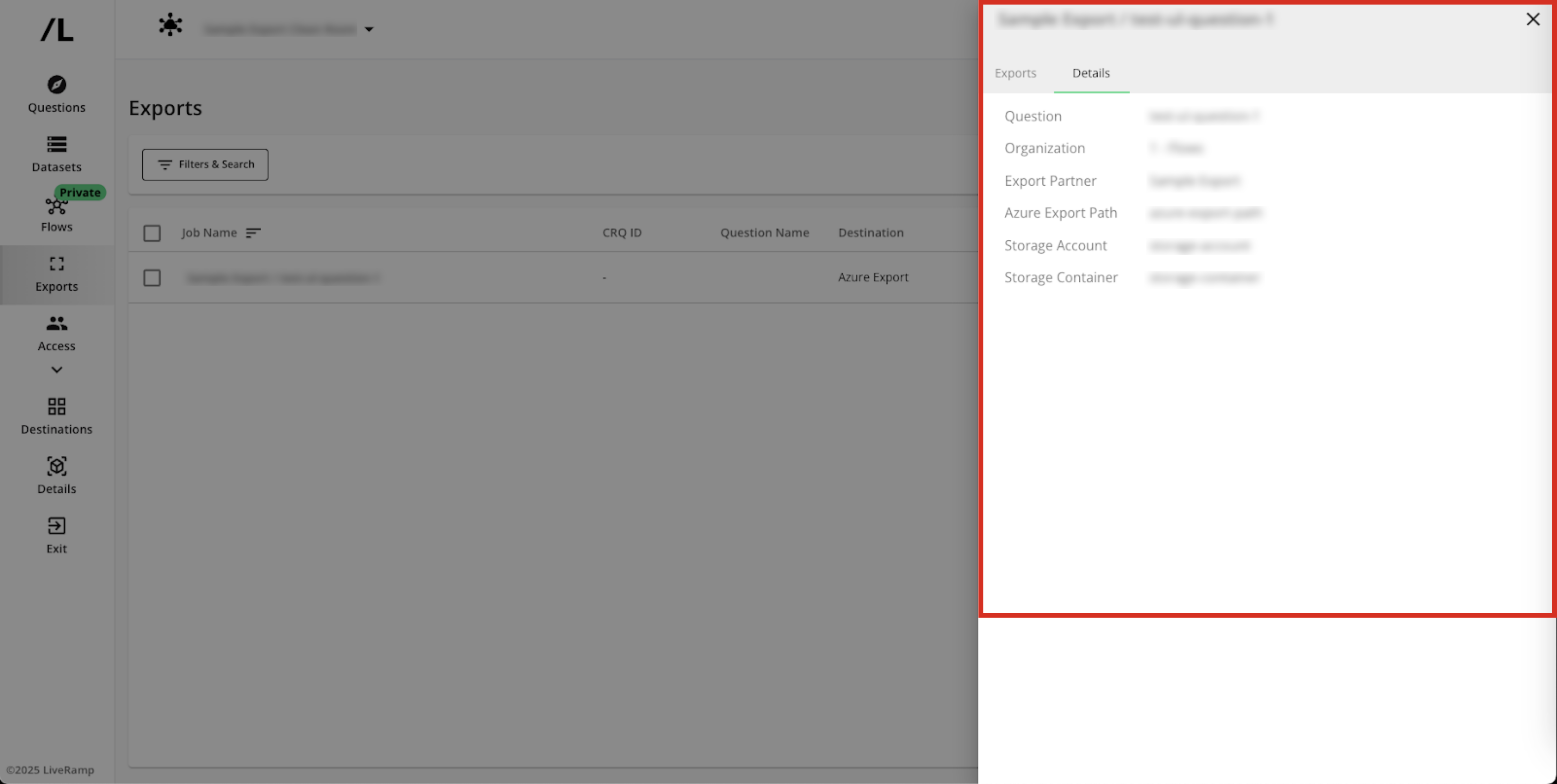
Note
Exports can be paused, which will stop them from sending data upon the completion of each run.
Exports cannot be edited or deleted. Changes should be made by pausing the export and creating a new export.
The name of the export will be the name of the question with a timestamp appended to the end of the name (for example, the question "Export_List_Question_18_Aug_CSV_Enabled" will be exported as "Export_List_Question_18_Aug_CSV_Enabled_2025-08-18_10-02-36", along with the appropriate file extension).
To use a custom file name, create a support case after you create the export job and include the export job name, the custom file name pattern you want, and the name of the question.
Export Details
When a question runs, the results will be written to the defined bucket. Each row will have an associated "Run ID" column. There will be a second metadata table created. Users can join on Run ID to get run metadata (Run Name, Runtime Parameters, etc.).
Azure Export File Structure
abfss://<container>@<account>.dfs.core.windows.net/<export-path>/
/date=<yyyy-mm-dd>
/cleanroom=<clean-room-id>
/question=<clean-room-question-id>
/run=<run-id>
/data ← For analytical questions, this contains 1 .csv file. For user list questions, this contains 1+ .parquet files with list data.
Note
List files do not contain column headers
metadata.json ← This contains each column header name, data type, and whether it is encrypted. If encryption is used, the dek and kek are also provided.